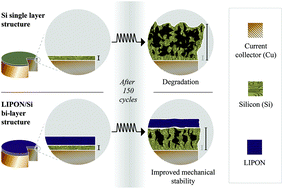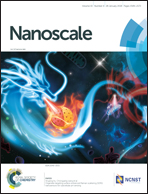A step towards understanding the beneficial influence of a LIPON-based artificial SEI on silicon thin film anodes in lithium-ion batteries
Abstract
In this work, we present a comprehensive study on the influence of lithium phosphorus oxynitride (LIPON) as a possible “artificial SEI layer” on the electrochemical performance of pure silicon (Si) thin film electrodes for a possible application in microbatteries or on-chip batteries. Si thin film anodes (140 nm) with and without an additional amorphous LIPON surface layer of different thicknesses (100–300 nm) were prepared by magnetron sputter deposition. The LIPON surface coating was characterized thoroughly by means of electrochemical impedance spectroscopy, Raman spectroscopy, X-ray photoelectron spectroscopy and atomic force microscopy. In situ electrochemical dilatometry and ex situ cross-section analysis of the electrodes after cycling could prove that the LIPON coating greatly diminishes the volume expansion of the Si electrode and, therefore, significantly improves the cycling stability and capacity retention. Furthermore, the LIPON coating remarkably reduces parasitic electrolyte decomposition reactions that originate from the Si volume expansion and contribute to the overall electrode volume expansion, as observed by the enhanced Coulombic efficiency over ongoing charge/discharge cycling. Overall, this article focuses on the preparation of optimized Si-based thin film electrodes in combination with LIPON solid electrolyte coatings for use in high-energy lithium ion batteries.



 Please wait while we load your content...
Please wait while we load your content...